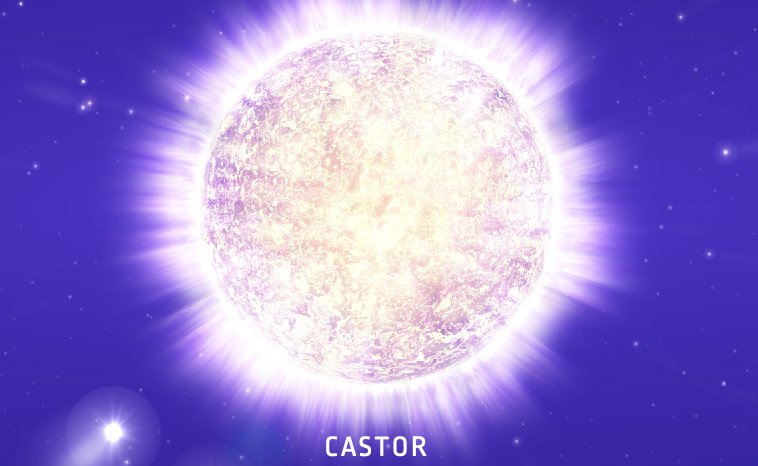Castor – Star Facts

Castor is from the Latin language meaning ‘beaver’. Castor is actually made up of six stars with three pairs of binary stars being all gravitationally bound to each other. The mythology surrounding Castor dates back to the early Greeks. They believed that Castor and his brother, Pollux were ‘half’ twins. The boys were also alleged to have sailed with Jason and the Argonauts.
Constellation Home
Castor is located approximately 51 light-years away in the constellation of Gemini. This constellation is the 30th in size (out of the 88) and is home to several deep space objects including the Medusa, Eskimo and Jellyfish Nebulae. Gemini is also a part of the Zodiac family of constellations.
Observation
This star can be seen in its home constellation located in the second quadrant of the Northern hemisphere, specifically between latitudes of +90 and -60 degrees. It marks the head of the second twin in Gemini. Because this star is so bright it can be viewed by the unaided eye and for most people about 10 months out of the year. The best times to view Castor is in late November through May in the evening sky. This star will be opposite the Sun in mid-January and well placed for easy viewing in February about an hour after sunset. However, the Sun does cross paths with Castor around July 14th so for several weeks before and after this date, Castor will be impossible to spot.

Star Characteristics and Features
Castor may appear as a single star to the unaided eye; however, it is actually made up of six stars (three pairs of binary stars all gravitationally bound to each other). The four main stars of Castor are spectroscopic binary systems consisting of a primary component of a spectral class A1 V and a companion star being a spectral type M5 V. The secondary system is composed of a stellar A2 Vm star and a M2 V star. In addition, the last pair of stars are an eclipsing binary with both being class M dwarfs. The two main components have a revolutionary period of about 467 years. The eclipsing binary system has a period of just under 24 hours.
Brightness of the Star
Alpha Geminorum is the second brightest star in Gemini constellation despite its Alpha designation (Pollux is the brightest) and also one of the brightest in the night sky. It has a combined apparent magnitude of 1.58.
History and Mythology
The mythology surrounding Castor dates back to the early Greeks. They believed that Castor and his brother (Pollux) were twins or rather “half” twins. As the legend tells Queen Leda became pregnant with both boys on the same night; one boy was immortal and belonged to Zeus, while Castor was mortal and his father was King Tyndareus. The twins were also alleged to have sailed with Jason and the Argonauts. Because these boys were so close, Zeus placed them in the stars where they could forever be together.
The home constellation of the twins was first catalogued in the 2nd century by a Greek astronomer known as Ptolemy. However, both Ptolemy and Hyginus associated the two prominent stars of Gemini as the two half-brothers of Zeus (Hercules and Apollo). In Arabic culture, Castor was known as Al-Ras al-Taum al-Muqadim meaning “The Head of the Foremost Twin.”
Castor is not just another twinkling celestial object, it has some cold hard facts and true significance. So if you have a chance to view this fascinating star of “the twins” be sure to check it out.
